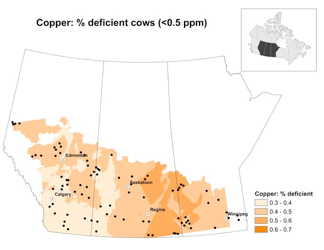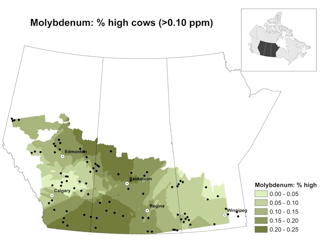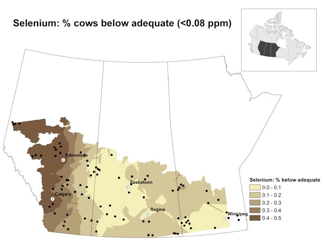The Importance of Trace Minerals
Titre de Projet
Optimizing Calving Outcomes in Cow-Calf Herds Through More Effective Management of Micronutrient Supplementation Programs
Des Cherchers
Dr. Cheryl Waldner cheryl.waldner@usask.ca
Dr. Cheryl Waldner, Dr. John Campbell, Dr. Sarah Parker, Dr. Murray Jelinski (Western College of Veterinary Medicine)
| Le Statut | Code de Project |
|---|---|
| Terminé en July, 2016 | ANH.10.14 |
BACKGROUND
Trace minerals are an essential part of a complete nutrition program. Deficiencies in trace minerals can reduce growth, milk production, and reproductive rate. Trace mineral deficiencies can also cause a variety of metabolic diseases. For example, copper deficiency has been linked to reduced pregnancy rates, and selenium deficiency can cause white muscle disease in calves. A recent Saskatchewan study found that zinc and copper concentrations were inadequate in forage sampled during spring and fall to meet the requirements for both beef cows (dry and lactation) and growing calves in all soil zones. A 2001 study examined 2516 heifers and cows from 66 herds across western Canada and discovered that 16% were copper deficient, although other literature suggests this number could be as high as 46%.
This is the first study since 2001 to examine trace mineral status in a large number of animals and herds in western Canada. Herd size and management practices have changed substantially since then, especially with the increased adoption of extended grazing.
OBJECTIVES
- To identify geographical regions at high risk for micronutrient deficiencies and evaluate the impact of micronutrient status and supplementation practices on calving outcomes.
WHAT THEY DID
This study utilized the Western Canadian Cow-Calf Surveillance Network for herd enrollment. Blood samples were collected from 103 herds (53 from Alberta, 32 from Saskatchewan and 18 from Manitoba) at fall pregnancy testing, representing 2050 individual cows and heifers. Owners were asked to provide information about the type, form, and method of supplementation provided in the period prior to sample collection and also between pregnancy testing and calving. Information on calving outcomes was also provided.
A soil zone map was used to designate the location of each herd as being in the grey, dark grey, black, dark brown or brown soil zones.
WHAT THEY LEARNED
Copper deficiency was the most common trace mineral deficiency discovered, with 43% of cows affected. Herds sampled in November were more likely to be copper deficient than herds sampled in October or December. High molybdenum levels were reported in 13% of cows, which may explain a portion of the high level of copper deficiency, as high molybdenum concentrations interfere with copper utilization. Selenium deficiency was relatively rare, at 0.4%, however 22% of cows had less than adequate selenium levels.
All herds did provide trace mineral supplementation prior to calving, but not all herds provided trace mineral supplements during the breeding season. Over half of herd owners provided supplementation free-choice. Vitamins A and E were rarely supplemented in cows, but approximately half of producers provided vitamin A and selenium injections to newborn calves.
Herds located on grey soil types were three times more likely to have copper deficient cows, but interestingly, soil type explained less than 2% of the total variation in frequency of copper deficiency in herds. Neither selenium nor molybdenum status were associated with soil type.
The herds in this study had an extremely low rate of abortion and early calf death loss, which made it difficult to draw any conclusions regarding selenium deficiencies and calving outcomes, a question initially raised in the 2001 study. While not statistically significant, there was a trend linking low serum selenium concentrations and calf losses within the first three weeks after calving.
WHAT IT MEANS
This study was able to identify geographical patterns in trace mineral deficiencies.



One explanation for the geographical patterns of deficiencies may be the types of forage grazed during the summer and fall. While not examined in this study, a 2014 study examining the trace mineral status of Saskatchewan pastures found significant differences between forage species in trace mineral content.
Supplementation rates in this study were consistent with the results of the Western Canadian Cow/Calf Survey, which reported that 98% of respondents provided trace mineralized salt or loose mineral during the winter, and 95% in the summer. However, there are still a high proportion of cows that are not reaching optimal trace mineral status, especially with regards to copper. This may be due, in part, to the difficulty of ensuring consistent consumption, as free-choice intake can be highly variable. In this case, owners were required to report the provision of supplement, but amount provided to or consumed by the cattle was unknown. Previous work has found that cows fed trace mineral free-choice were six times more likely to be below adequate levels of copper at calving, and experienced a delay coming back into heat compared to those fed trace minerals mixed into a ration.
Forage testing, both on pasture and in stored feed, can identify trace mineral content and flag any potential mineral antagonisms that may result in deficiencies impacting the health and reproductive status of cows.
More information on mineral deficiencies, developing an optimum mineral feeding program, the economic advantages of supplementation, tips for preventing over or under consumption, mineral interactions, and how cow mineral requirements change throughout the year can be found here.
This project was also supported by the Saskatchewan Agriculture Development Fund